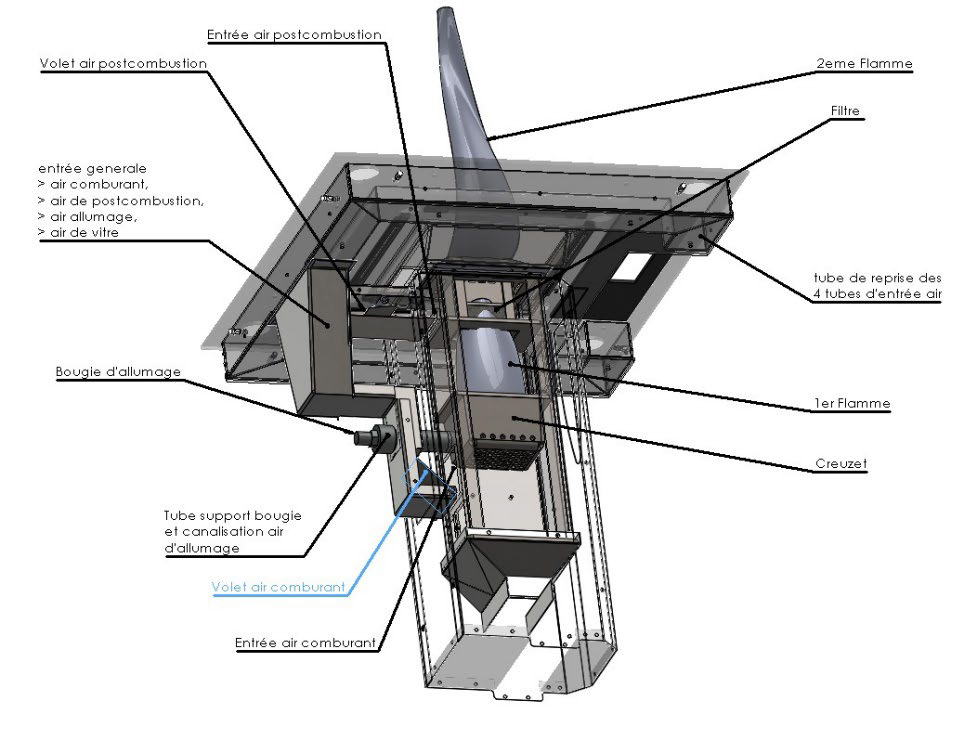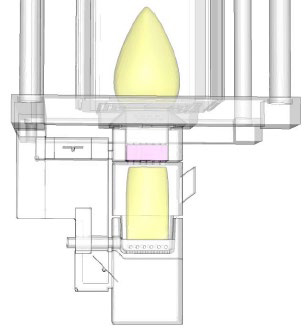Innovating concept Schulhof Énergie
The combustion unit is independent and autonomous.
It includes the crucible, which is located 230 mm below the part that reveals the flame.
Above the crucible, a special part filters the particles carried by the first flame and injects a separate flow of air known as post-combustion air.
This assembly receives the overall air flow from the top of the stove and divides it into 4 separate flows:
1. The air injected around the spark plug, which ensures ignition.
2. Combustion air injected below the crucible.
3. A separate flow of air constituting the post-combustion flow.
Each of these two flows, combustion air and post-combustion air, is controlled by a separate shutter which allows the combustion phases to alternate during the power phase, alternating between combustion phases (which promote direct combustion of the pellets in the crucible) and post-combustion phases which promote combustion of the gases in the flame at a height of approximately 230 mm above the bottom of the crucible.
4. A flow of air known as window air, which is distributed in several parts over each of the four windows surrounding the flame.
In the post-combustion phase, the pellets accumulated at the bottom of the crucible burn and rise in temperature, giving off gases that are ignited by the post-combustion flow.
This second combustion causes the flame temperature to rise, promoting the combustion of the carbon monoxide contained in the flame and reducing emissions of this greenhouse gas.
This increase in combustion temperature (from around 400°C to 800°C) helps to increase efficiency by efficiently transferring the heat contained in the flame and the smoke by means of two fans that distribute a flow of air around the periphery of the combustion unit, which is sealed off from its surroundings, and the smoke recovery system, which is also sealed off from its surroundings.
To avoid the accumulation of charcoal pellets in the bottom of the crucible, the program alternates between two combustion modes over an appropriate period of time.
The quality of combustion is constantly monitored by a lambda probe, which analyses the oxygen content of the fumes in order to interact and optimise the fuel (pellets) and combustive (air) mixture.
Having two forced heat exchange points - one around the combustion system and the other in the upper part above the flame in the smoke recovery system - results in exceptional performance in terms of efficiency.
The other is in the flue gas exchanger at the top of the stove, above the flame.
The new combustion concept, thanks to its architecture, allows post-combustion air to be injected with the utmost efficiency, in addition to a filter that retains the largest particles produced by the combustion of wood pellets.
Favouring post-combustion over primary combustion for a short period of time leads to pyrolysis, which, through the gasification it causes and by reducing the oxygen supply to prevent oxidation and combustion (reduction of the flame), generates more gas and also more carbon in the fuel.
By acting on the flaps distributing the flow between the combustion air and the post-combustion air, we alternate between two combustion phases, either the combustion of gas from pyrolysis or the primary combustion of wood pellets.
A first control loop ensures a constant balance between the quantity of pellets supplied by the endless screw and the overall quantity of air entering the combustion system for a defined power output.
A second computer-controlled control loop takes into account the oxygen content of the flue gases measured by the lambda sensor, and acts on the two flaps distributing the combustion and post-combustion air flows.
This is done via a control loop and controlled by measurements of the oxygen content of the smoke taken by a lambda sensor.
These are all functions performed for the first time anywhere in the world by the combustion concept behind the V13 and V14 stoves.
The control system
Since this stove has operating characteristics that are both unusual and unknown to date for a wood pellet stove, it has been necessary to develop a specific PCB and a specific control software to control the stove.
This PCB and the specific control software will be sold exclusively by Schulhof Energies.
Innovative design
With its highly integrated 'form and function', the V14 fits perfectly into the décor and ambiance of the house. The high flame, visible from every angle of the stove, and even 360° in the case of the round model, allows users to rediscover the sensations and warmth of a wood fire in a fireplace.
This new design means that the stove can be redefined in terms of its position in the fireplace or in the room.
This integration of technical constraints into a highly polished design will make a real difference to the marketing positioning of our product.
All these innovations justified the filing of 3 patents relating to functional innovations, plus 1 patent relating to designs and models.
Shapes and cladding
This stove comes in a number of shapes (square, circular, rectangular, fireplace insert) and several types of cladding, with variations in materials and patterns for sheet metal cladding. This allows the range to be extended and generates a great deal of diversification and customisation.
PATENTS
These patents apply to all models (square or cylindrical or other) of stove incorporating this combustion system.
The filter
Above the first flame: a specific component incorporates a volume in which is placed a mixture of 3 materials which withstand high combustion temperatures and which, depending on their expansion, create a complex flow whose purpose is to retain the various particles carried along in the flame resulting from the combustion of the wood pellets contained in the crucible. This encourages their combustion in addition by an initial rise in temperature due to the inertia generated by these components. This function is patented.
The post-combustion air diffusion system
Thanks to its structure at the periphery of the flame which passes through its centre, the same part allows a second flow of air, known as the afterburner air, to be injected.
This creates a second flame above the first.
This flame is fed by the gases generated by the pyrolysis phenomenon resulting from the rise in temperature of the granulate burning at the bottom of the crucible.
As this component is heated to a measured temperature of around 600°C for an 8 kW output, this causes the temperature of the post-combustion air to rise (300°C for an 8 kW output), which in turn causes the temperature of the flame and fumes to rise to between 800 and 1,100°C.
This function is patented.
This part therefore performs 2 functions and is protected by two separate patents.
The flue gas heat exchange system
Above the flame in the upper part of the stove, there is a casing that carries out a heat exchange to transfer the calories contained in the smoke to the surrounding volume of air intended to be heated by the stove.
This is one of the two heat recovery functions, the other being around the combustion system.
The structure, design and operation of this component as a whole are patented.
Consolidation patent for the V14 stove as a whole
In order to solidify the protection of the model V14 stove, a final patent protects the overall concept that defines its architecture through the three parts that make up its structure and organisation.
This fourth patent incorporates the 3 other patents and defines the stove concept as an innovation in itself, thanks to its ability to display the flame 360° around it.

